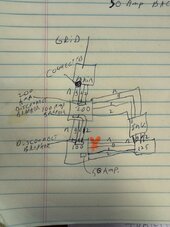Ok, this is a little odd and maybe even not so smart, but want to be sure. I will try to be clear. see picture sorry for bad hand writing. I should start with the house panels. I have 400 amp service. One line goes to the main house 200 amp panel and the other is not important to this. There is a 200 amp disconnect breaker built in to the second panel. There is a 100 amp line to another panel. There is also a 200 amp disconnect breaker on that panel. I have the 200 amp panel feeing to my inverter with a 30 amp breaker. I use a pigtail to plug into the inverter. The inverter feeds another small 135 amp panel. There are 2 x 30 amp breakers. One breaker goes to the 100 amp panel with a 30 amp breaker back feeding to it. The intent was in an emergency I could run lights, fans fridge. Essentially an emergency feed panel from the inverter. I would just isolate it from the 200 amp panel and be good to go. I can and have in an extended situation isolated the 200 amp panel from the main / grid and ran some other minor items from the 200 amp panel from the 100 amp panel. So essentially back feeding from the 100 to the 200 amp panel. So to the question. I can technically back feed both panels with 2 separate 30 amp breakers. Doing so independently is no problem. But could I feed both panels and leave the breaker closed between them. Effectively looping the 2 x 30 amp lines for hopefully 60 amp combined. Or will there potentially be a phase issue with 2 lines not the same length. Yes I know I need to get the phases correct in each panels. But could I have an issue. They are probably within 10’ to 20’ of being the same length lines to them. Eventually I will have the solark 15k just runs everything like it should. It would go between the main and the 200 amp panel. Then there should be no issues. It just may take a little while to get that done. Thanks for any input. 






